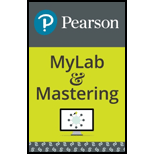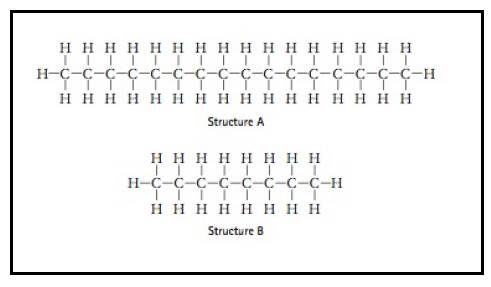
EP CONCEPTUAL PHYSICAL SCI.-MOD.MASTER.
6th Edition
ISBN: 9780134091983
Author: Hewitt
Publisher: PEARSON CO
expand_more
expand_more
format_list_bulleted
Question
Chapter 15, Problem 77E
To determine
Of the two structures given below, the one which belong to the structure of gasoline and the other one that belong to structure of motor oil.

Expert Solution & Answer
Want to see the full answer?
Check out a sample textbook solution
Students have asked these similar questions
2
3
Imagine you are out for a stroll on a sunny day when you encounter a lake. Unpolarized light from the sun is reflected off the lake into your eyes. However, you notice when you put on your vertically polarized sunglasses, the light reflected off the lake no longer reaches your eyes. What is the angle between the unpolarized light and the surface of the water, in degrees, measured from the horizontal? You may assume the index of refraction of air is nair=1 and the index of refraction of water is nwater=1.33 . Round your answer to three significant figures. Just enter the number, nothing else.
Chapter 15 Solutions
EP CONCEPTUAL PHYSICAL SCI.-MOD.MASTER.
Ch. 15 - How many electrons can occupy the first shell? How...Ch. 15 - Which electrons are represented by an electron-dot...Ch. 15 - Prob. 3RCQCh. 15 - How does an ion differ from an atom?Ch. 15 - To become a negative ion, does an atom lose or...Ch. 15 - Why does the fluorine atom tend to gain only one...Ch. 15 - Prob. 7RCQCh. 15 - Suppose an oxygen atom gains two electrons to...Ch. 15 - Prob. 9RCQCh. 15 - Do metals more readily gain or lose electrons?
Ch. 15 - What is an alloy?Ch. 15 - What is a native metal?Ch. 15 - Prob. 13RCQCh. 15 - Prob. 14RCQCh. 15 - Within a neutral molecule, how many covalent bonds...Ch. 15 - Prob. 16RCQCh. 15 - Prob. 17RCQCh. 15 - Prob. 18RCQCh. 15 - Prob. 19RCQCh. 15 - How can a molecule be nonpolar when it consists of...Ch. 15 - Why do nonpolar substances boil at relatively low...Ch. 15 - Which is more symmetrical: a polar molecule or a...Ch. 15 - Why dont oil and water mix?Ch. 15 - Prob. 24RCQCh. 15 - Which is stronger: the ion-dipole attraction or...Ch. 15 - What is a hydrogen bond?Ch. 15 - Are induced dipoles permanent?Ch. 15 - Prob. 31TASCh. 15 - What is the electric charge on the calcium ion in...Ch. 15 - Prob. 33TASCh. 15 - Prob. 34TASCh. 15 - Rank these bonds in order of increasing polarity:...Ch. 15 - Prob. 36TARCh. 15 - Prob. 37TARCh. 15 - Prob. 38TARCh. 15 - Prob. 39ECh. 15 - Prob. 40ECh. 15 - How many more electrons can fit within the valence...Ch. 15 - Prob. 42ECh. 15 - What happens when hydrogens electron gets close to...Ch. 15 - Prob. 44ECh. 15 - Why does an atom with few valence electrons tend...Ch. 15 - Why is it so easy for a magnesium atom to lose two...Ch. 15 - Why doesnt the neon atom tend to lose or gain any...Ch. 15 - Why does an atom with many valence electrons tend...Ch. 15 - Sulfuric acid, H2SO4, loses two protons to form...Ch. 15 - Prob. 50ECh. 15 - Which should be more difficult to pull apart: a...Ch. 15 - Prob. 52ECh. 15 - Given that the total number of atoms on our planet...Ch. 15 - An artist wants to create a metal sculpture using...Ch. 15 - Two fluorine atoms join together to form a...Ch. 15 - How are metallic bonds similar to ionic bonds? How...Ch. 15 - What drives an atom to form a covalent bond: its...Ch. 15 - Atoms of nonmetallic elements form covalent bonds,...Ch. 15 - Prob. 59ECh. 15 - Prob. 60ECh. 15 - Write the electron-dot structure for the covalent...Ch. 15 - Prob. 62ECh. 15 - In each molecule, which atom carries the greater...Ch. 15 - Which is more polar: a sulfur-bromine (S-Br) bond...Ch. 15 - True or False: The greater the nuclear charge of...Ch. 15 - True or False: The more shells in an atom, the...Ch. 15 - Water, H2O, and methane, CH4, have about the same...Ch. 15 - In the figure on the next page, the molecule from...Ch. 15 - Prob. 69ECh. 15 - Three kids sitting equally apart around a table...Ch. 15 - Which is stronger: the covalent bond that holds...Ch. 15 - The charges with sodium chloride are all...Ch. 15 - Prob. 73ECh. 15 - Prob. 74ECh. 15 - Prob. 75ECh. 15 - A thin stream of water is pulled to a rubber...Ch. 15 - Prob. 77ECh. 15 - Prob. 1RATCh. 15 - Prob. 2RATCh. 15 - Which would you expect to have a higher melting...Ch. 15 - Why are ores so valuable? (a) They are sources of...Ch. 15 - In terms of the periodic table, is there an abrupt...Ch. 15 - A hydrogen atom does not form more than one...Ch. 15 - When nitrogen and fluorine combine to form a...Ch. 15 - Prob. 8RATCh. 15 - Prob. 9RATCh. 15 - Iodine, I2, has a higher melting point than...
Knowledge Booster
Similar questions
- 20. Two small conducting spheres are placed on top of insulating pads. The 3.7 × 10-10 C sphere is fixed whie the 3.0 × 107 C sphere, initially at rest, is free to move. The mass of each sphere is 0.09 kg. If the spheres are initially 0.10 m apart, how fast will the sphere be moving when they are 1.5 m apart?arrow_forwardpls help on allarrow_forwardpls help on thesearrow_forward
- pls help on all asked questions kindlyarrow_forwardpls help on all asked questions kindlyarrow_forward19. Mount Everest, Earth's highest mountain above sea level, has a peak of 8849 m above sea level. Assume that sea level defines the height of Earth's surface. (re = 6.38 × 106 m, ME = 5.98 × 1024 kg, G = 6.67 × 10 -11 Nm²/kg²) a. Calculate the strength of Earth's gravitational field at a point at the peak of Mount Everest. b. What is the ratio of the strength of Earth's gravitational field at a point 644416m below the surface of the Earth to a point at the top of Mount Everest? C. A tourist watching the sunrise on top of Mount Everest observes a satellite orbiting Earth at an altitude 3580 km above his position. Determine the speed of the satellite.arrow_forward
- pls help on allarrow_forwardpls help on allarrow_forward6. As the distance between two charges decreases, the magnitude of the electric potential energy of the two-charge system: a) Always increases b) Always decreases c) Increases if the charges have the same sign, decreases if they have the opposite signs d) Increases if the charges have the opposite sign, decreases if they have the same sign 7. To analyze the motion of an elastic collision between two charged particles we use conservation of & a) Energy, Velocity b) Momentum, Force c) Mass, Momentum d) Energy, Momentum e) Kinetic Energy, Potential Energyarrow_forward
arrow_back_ios
SEE MORE QUESTIONS
arrow_forward_ios
Recommended textbooks for you
 Physics for Scientists and Engineers with Modern ...PhysicsISBN:9781337553292Author:Raymond A. Serway, John W. JewettPublisher:Cengage Learning
Physics for Scientists and Engineers with Modern ...PhysicsISBN:9781337553292Author:Raymond A. Serway, John W. JewettPublisher:Cengage Learning An Introduction to Physical SciencePhysicsISBN:9781305079137Author:James Shipman, Jerry D. Wilson, Charles A. Higgins, Omar TorresPublisher:Cengage Learning
An Introduction to Physical SciencePhysicsISBN:9781305079137Author:James Shipman, Jerry D. Wilson, Charles A. Higgins, Omar TorresPublisher:Cengage Learning Modern PhysicsPhysicsISBN:9781111794378Author:Raymond A. Serway, Clement J. Moses, Curt A. MoyerPublisher:Cengage Learning
Modern PhysicsPhysicsISBN:9781111794378Author:Raymond A. Serway, Clement J. Moses, Curt A. MoyerPublisher:Cengage Learning Foundations of Astronomy (MindTap Course List)PhysicsISBN:9781337399920Author:Michael A. Seeds, Dana BackmanPublisher:Cengage Learning
Foundations of Astronomy (MindTap Course List)PhysicsISBN:9781337399920Author:Michael A. Seeds, Dana BackmanPublisher:Cengage Learning Stars and Galaxies (MindTap Course List)PhysicsISBN:9781337399944Author:Michael A. SeedsPublisher:Cengage Learning
Stars and Galaxies (MindTap Course List)PhysicsISBN:9781337399944Author:Michael A. SeedsPublisher:Cengage Learning


Physics for Scientists and Engineers with Modern ...
Physics
ISBN:9781337553292
Author:Raymond A. Serway, John W. Jewett
Publisher:Cengage Learning

An Introduction to Physical Science
Physics
ISBN:9781305079137
Author:James Shipman, Jerry D. Wilson, Charles A. Higgins, Omar Torres
Publisher:Cengage Learning

Modern Physics
Physics
ISBN:9781111794378
Author:Raymond A. Serway, Clement J. Moses, Curt A. Moyer
Publisher:Cengage Learning

Foundations of Astronomy (MindTap Course List)
Physics
ISBN:9781337399920
Author:Michael A. Seeds, Dana Backman
Publisher:Cengage Learning

Stars and Galaxies (MindTap Course List)
Physics
ISBN:9781337399944
Author:Michael A. Seeds
Publisher:Cengage Learning